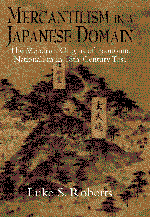Book contents
- Frontmatter
- Contents
- List of maps, tables, and figures
- Acknowledgments
- Dates and units of measurement used in the text
- Maps
- 1 Introduction
- 2 The geography and politics of seventeenth-century Tosa
- 3 Creating a crisis in Tosa, 1680–1787
- 4 The decline and restoration of domain finances
- 5 Voices of dissatisfaction and change: The petition box
- 6 Imagined economies: Merchants and samurai
- 7 Declining service
- 8 Cooking up a country: Sugar, eggs, and gunpowder, 1759–1868
- 9 Conclusion
- Glossary of terms and manuscript document titles used in the text
- Sources for figures and tables
- Works and documents cited
- Index
4 - The decline and restoration of domain finances
Published online by Cambridge University Press: 17 September 2009
- Frontmatter
- Contents
- List of maps, tables, and figures
- Acknowledgments
- Dates and units of measurement used in the text
- Maps
- 1 Introduction
- 2 The geography and politics of seventeenth-century Tosa
- 3 Creating a crisis in Tosa, 1680–1787
- 4 The decline and restoration of domain finances
- 5 Voices of dissatisfaction and change: The petition box
- 6 Imagined economies: Merchants and samurai
- 7 Declining service
- 8 Cooking up a country: Sugar, eggs, and gunpowder, 1759–1868
- 9 Conclusion
- Glossary of terms and manuscript document titles used in the text
- Sources for figures and tables
- Works and documents cited
- Index
Summary
Finances have reached this level of hardship and many years of impoverishment because We have passed the time thoughtlessly and inattentively. We are extremely dissatisfied. We declare a cut in expenses in Edo and the country to within the level of our income beginning now. Furthermore, We have requested to the shogun that We may live at a status of 100,000 koku. If this reform does not succeed, then We do not deserve being granted this country and can do nothing other than give it up. Know our heart: All, high and low, must accept this together.
Domain lord Yamauchi Toyochika, eighth month 1787The financial condition of Tosa domain worsened steadily over most of the eighteenth century. Because seventeenth-century finances were so dependent on lumber income, the disappearing stands of forest devastated finances as directly as they harmed the Tosa environment and economy. Furthermore, because overpopulation problems contributed to crop losses and difficulties with tax payment, they also troubled financial officials. Bakufu demands for labor duty in the eighteenth century became standardized as a monetary contribution for almost all domains, Tosa included, but the sudden calls for money inevitably sent domain finances reeling. Furthermore, normal Edo expenditures continued to grow: a by-product of the culture of conspicuous consumption in which the lords and their families lived. When lumber was plentiful in the seventeenth century, the lords of Tosa were very well off and could afford to be insouciant.
- Type
- Chapter
- Information
- Mercantilism in a Japanese DomainThe Merchant Origins of Economic Nationalism in 18th-Century Tosa, pp. 85 - 102Publisher: Cambridge University PressPrint publication year: 1998



